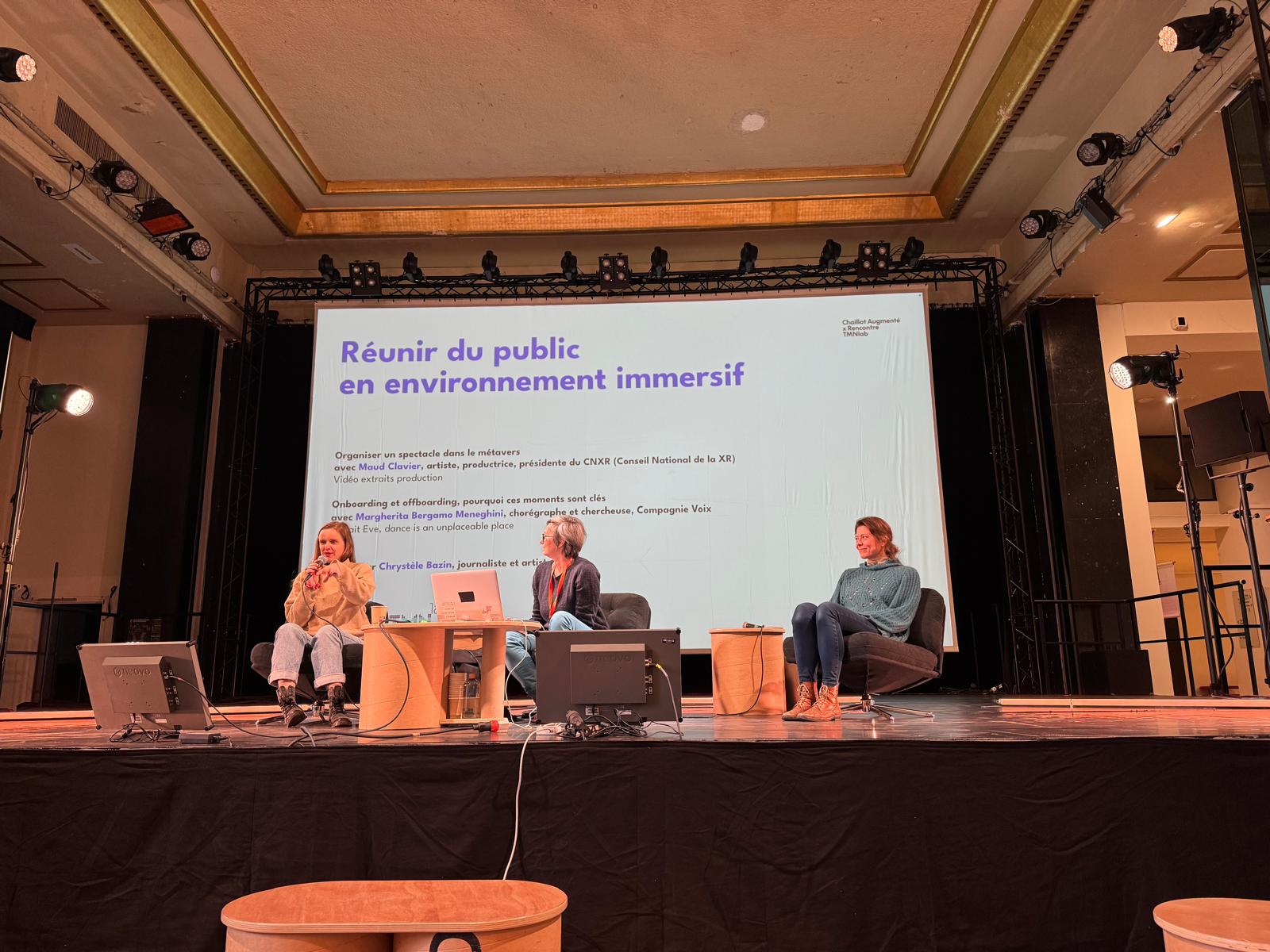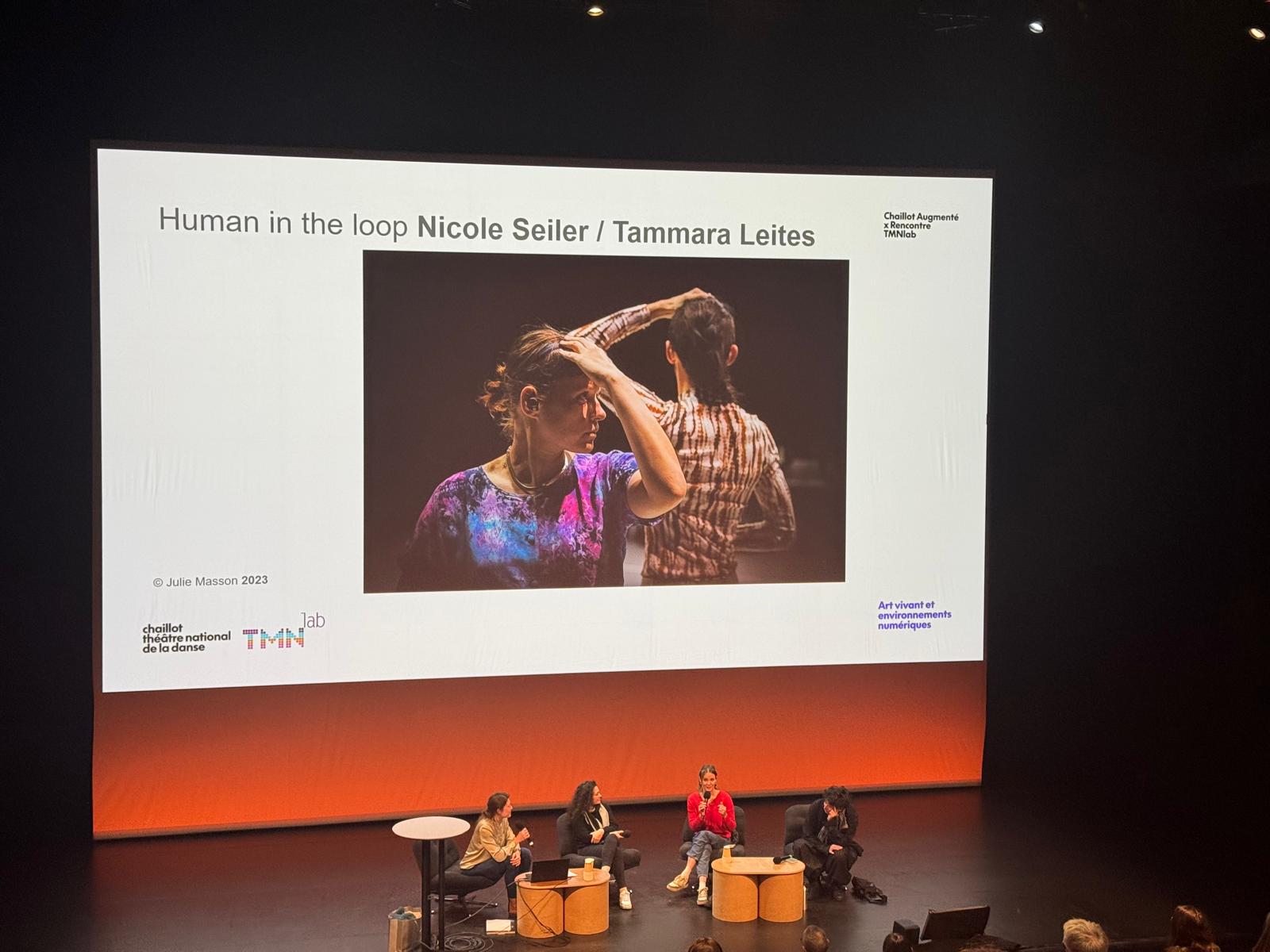Journal
Chaillot Augmenté x Rencontres TMNlab
Published on 16.02.2025
At the invitation of Anne Le Gall and Clément Coustenoble of TMNlab, I was able to participate in the conceptualisation process of two days of reflection, through interviews, round tables and demos on living art and digital environments, as part of the project Chaillot Augmenté.
On Thursday 13 February, I was interviewed by the journalist Chrystèle Bazin on the topic of Bringing together an audience in an immersive environment, and in particular on the key moments of onboarding and offboarding.
The word 'boarding' means to embark, to enter, to go up... a very familiar verb in the experience of taking a plane or a boat. The suffixes ON- and OFF- refer to activation and deactivation, thus making us think about what happens before and after the moment we board. This terminology is currently used in the context of virtual reality experiences to define the entry and exit of a virtual dimension reproduced by digital devices and which transcends that which we perceive as real. It is therefore interesting to note how the digital world appropriates terms that bring it closer to the experience of travel, of departure through a medium.
In my experience, I emphasise the evidence of creating a transmission framework, and also an atmosphere allowing to pass from one dimension to another, both in the sphere of live performance and in the sphere of the digital and the virtual. The parable of the immersion experience awakens the participant, whether actor or audience, from a sensory, motor and cognitive angle. There is a progression to the deepest point, and it can be gradual or abrupt. This entry transition is the moment to present the new dimension, to define its rules and boundaries, to convey the confidence to stay in the new dimension with the security of being able to leave it.
Later in the day, I was able to chair the round table discussion Artists, audiences, augmented or constrained bodies? with three artists active in the creation of dance, theatre and circus performances using the body and digital technologies: Corinne Linder, Éric Minh Cuong Castaing and Tammara Leites.
Corinne Linder is a creative director specialising in immersive experiences combining circus, immersive theatre and digital art, and is the founder of the Fheel Concept Company, based in Toulouse. In 2016, following an accident, a six-metre fall, she rethought her career and decided to pursue her artistic interests off stage to create concepts that fuse the language of circus with digital art. With Fheel Concepts, she aims to bring together different art forms, while retaining the fundamental principles of contemporary circus. She is the author of the creations ‘HOLD ON’ (2018) and ‘THE ORDINARY CIRCUS GIRL’ (2019), in which she explores how VR and MR can augment the body and enable to become an athlete or artist virtually. She is working on a new production with heart rate sensors, 'VIBH20'.
Éric Minh Cuong Castaing is a choreographer and visual artist, founder of the Compagnie Shonen, based in Marseille, a resident company at Montpellier Danse. He combines technologies with his choreographic work from a critical perspective as ‘new structures of perception’ (in the words of Stéphane Vial, in 'L'être et l'écran', 2013). He proposes devices, on stage or off stage, renewing the relationship of bodies with each other and with their environment, the movement of humans and non-humans, the relationships of interdependence or co-presence of bodies. His creations include the piece ‘Phoenix’ (2018), a live video streaming between dancers on stage and Palestinian dancers in Gaza, the piece '_p/\rc__' (2022) where he works with children with disabilities, and the piece ‘HIKU’ (2023) with Anne Sophie Turion, where he works with isolated people, or hikikomoris, and telepresence robots. With his creations, he shows his interest in the specificity and atypicality of bodies, ‘deterritorialised’ bodies.
Tammara Leites is an artist, developer and interaction designer based in Geneva and Rome. Passionate about technology and its relationship with society, she reflects on what it means to be a connected human in everyday life. She is currently conducting research into human-machine interaction at the Transmii agency. Her project Metastories is an autonomous publishing house run entirely by artificial intelligence robots, promoting AI writers who create literature inspired by human-generated data. She is involved in the creation of the play ‘d.Simon’ (2021) with the performer Simon Senn, and later in the dance piece ‘Human in the loop’ (2023) with the choreographer Nicole Seiler, based on Donna Haraway's 'A Cyborg Manifesto'. There, she uses generative artificial intelligence to explore new forms of writing and interaction on stage.
The bodies of the artists and the audience are immersed in digital environments as part of the live art. How are these bodies projected, explored and stimulated? Which new forms of perception can they experience? Which new relationships can be created between them? The combination of digital environment and live performance presents bodies that can be defined as augmented or constrained? The ancestral experience of live performance allows for a collective encounter, an encounter of bodies. When we talk about living art, we are therefore talking about a collective body, about relationship. Today, digital technologies can affect this encounter with a commitment to and an augmentation of the collective, or on the contrary, with rather individualising implications. The relationship that develops between the bodies of the artists and the audience through immersive digital technologies in some cases brings people closer together, in others it creates distance. It stimulates the body, which feels a new sense of embodiment or also of disembodiment through a virtual experience. It confronts humans with technology, with machines, with robots and generative artificial intelligence. It deals with issues that can transcend circumstantial, geographical, cultural and gender boundaries, etc. Digital technology is being used to develop tools that make it possible to address sensitive issues, perhaps also making it possible to bring together the bodies of people who are marginalised or suffering from health problems, confinement or political issues.
The interest in exploring this idea of the ‘augmented body’, which was also the subject of an exhibition at the Centre Pompidou in 2022 by Art3mis, leads us to review other adjectives, such as the ‘mediatised’ body (Antonio Pizzo, 2018), the ‘mutant’ body (Ester Fuoco, 2018), the notions of ‘shared corporeality’ and ‘distributed agency’ (Samira Ibnelkaïd, 2018), or even all the variants of the term ‘cyborg’. Through these alterations, the bodies of the artists and the audience are brought into contact with each other, activating intermediate spaces. The creations bring together live performance, and therefore living bodies, with digital creation, and therefore the various virtual dimensions that can result from it.



